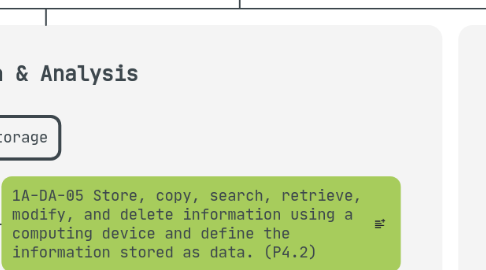
1. Computing Systems
1.1. Devices
1.1.1. 1B-CS-01 Describe how internal and external parts of computing devices function to form a system. (P7.2)
1.2. Hardware & Software
1.2.1. 1B-CS-02 Model how computer hardware and software work together as a system to accomplish tasks. (P4.4)
1.3. Troubleshooting
1.3.1. 1B-CS-03 Determine potential solutions to solve simple hardware and software problems using common troubleshooting strategies. (P6.2)
2. Networks & The Internet
2.1. Network Communication & Organization
2.1.1. 1B-NI-04 Model how information is broken down into smaller pieces, transmitted as packets through multiple devices over networks and the Internet, and reassembled at the destination. (P4.4)
2.2. Cybersecurity
2.2.1. 1B-NI-05 Discuss real-world cybersecurity problems and how personal information can be protected. (P3.1)
3. Data & Analysis
3.1. Storage
3.1.1. 1A-DA-05 Store, copy, search, retrieve, modify, and delete information using a computing device and define the information stored as data. (P4.2)
3.2. Collection, Visualization, & Transformation
3.2.1. 1B-DA-06 Organize and present collected data visually to highlight relationships and support a claim. (P7.1)
3.3. Inference & Models
3.3.1. 1B-DA-07 Use data to highlight or propose cause-and-effect relationships, predict outcomes, or communicate an idea. (P7.1)
4. Algorithms & Programming
4.1. Algorithms
4.1.1. 1B-AP-08 Compare and refine multiple algorithms for the same task and determine which is the most appropriate. (P6.3, P3.3)
4.2. Variables
4.2.1. 1B-AP-09 Create programs that use variables to store and modify data. (P5.2)
4.3. Control
4.3.1. 1B-AP-10 Create programs that include sequences, events, loops, and conditionals. (P5.2)
4.3.1.1. Third - Sequences, Loops
4.3.1.2. Fourth - Sequences, Loops, Conditionals
4.3.1.3. Fifth - All
4.4. Modularity
4.4.1. 1B-AP-11 Decompose (break down) problems into smaller, manageable subproblems to facilitate the program development process. (P3.2)
4.4.2. 1B-AP-12 Modify, remix, or incorporate portions of an existing program into one's own work, to develop something new or add more advanced features. (P5.3)
4.5. Program Development
4.5.1. 1B-AP-13 Use an iterative process to plan the development of a program by including others' perspectives and considering user preferences. (P1.1, P5.1)
4.5.2. 1B-AP-14 Observe intellectual property rights and give appropriate attribution when creating or remixing programs. (P7.3)
4.5.3. 1B-AP-15 Test and debug (identify and fix errors) a program or algorithm to ensure it runs as intended. (P6.1, P6.2)
4.5.4. 1B-AP-16 Take on varying roles, with teacher guidance, when collaborating with peers during the design, implementation, and review stages of program development. (P2.2)
4.5.4.1. Fourth
4.5.4.2. Fifth
4.5.5. 1B-AP-17 Describe choices made during program development using code comments, presentations, and demonstrations. (P7.2)
4.5.5.1. Fourth
4.5.5.2. Fifth
5. Impacts of Computing
5.1. Culture
5.1.1. 1B-IC-18 Discuss computing technologies that have changed the world, and express how those technologies influence, and are influenced by, cultural practices. (P7.1)
5.1.2. 1B-IC-19 Brainstorm ways to improve the accessibility and usability of technology products for the diverse needs and wants of users. (P1.2)
5.2. Social Interactions
5.2.1. 1B-IC-20 Seek diverse perspectives for the purpose of improving computational artifacts. (P1.1)
5.3. Safety, Law, & Ethics
5.3.1. 1B-IC-21 Use public domain or creative commons media, and refrain from copying or using material created by others without permission. (P7.3)
